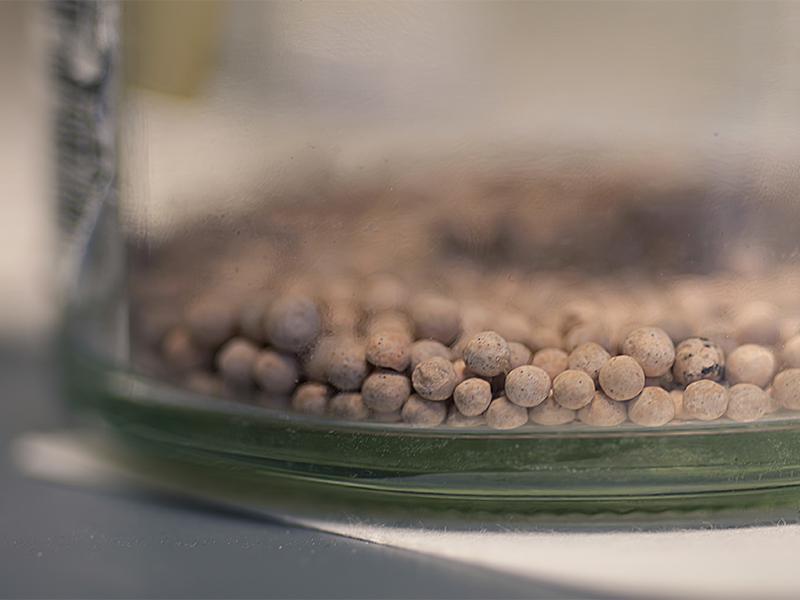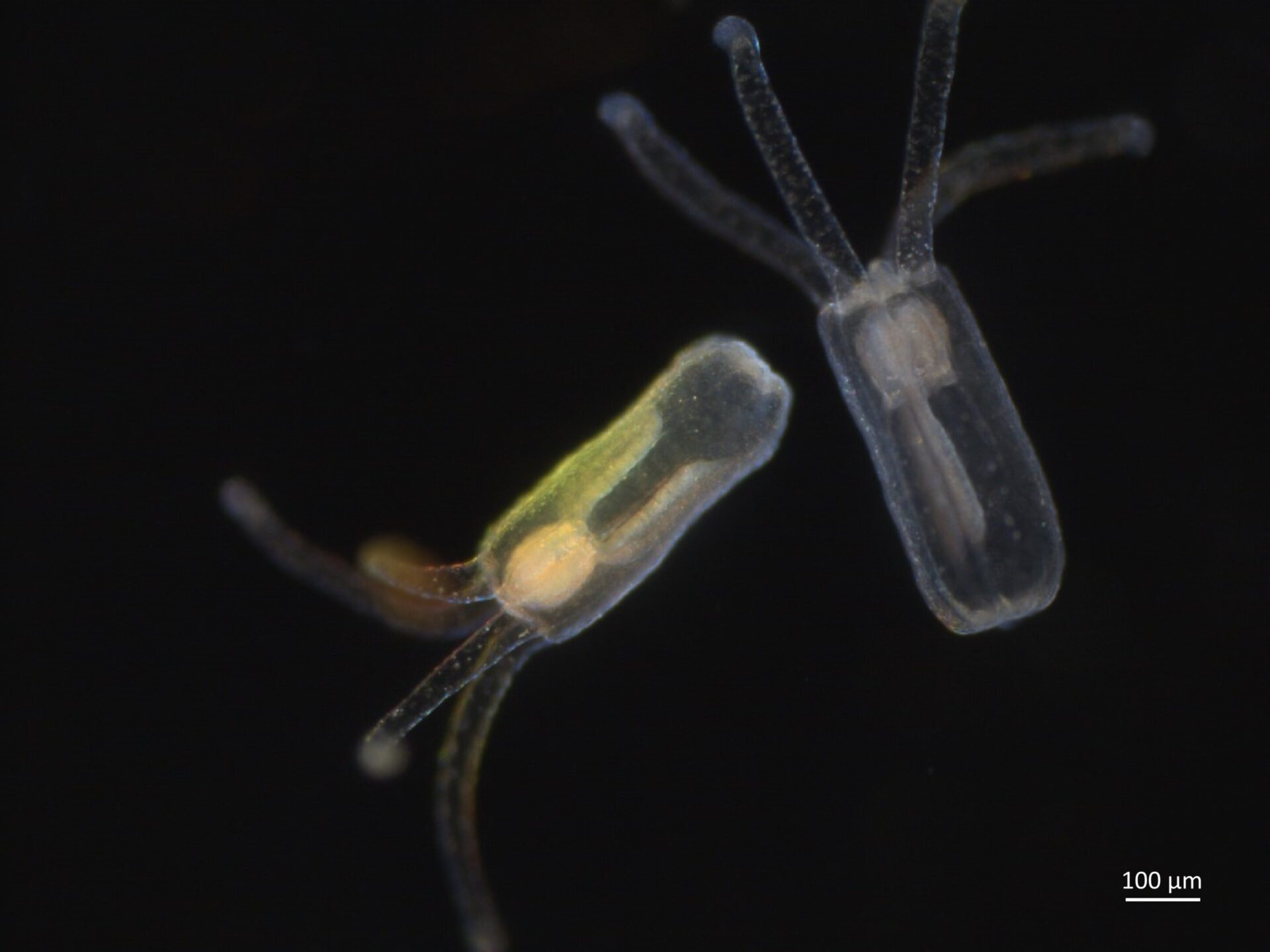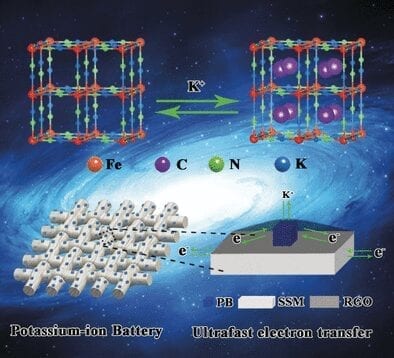
via Angewandte Chemie
Nonflammable electrolyte for high-performance potassium batteries
Australian scientists have developed a nonflammable electrolyte for potassium and potassium-ion batteries, for applications in next-generation energy-storage systems beyond lithium technology. In the journal Angewandte Chemie, scientists write that the novel electrolyte based on an organic phosphate makes the batteries safer and also allows for operation at reduced concentrations, which is a necessary condition for large-scale applications.
Lithium-ion technology still dominates energy-storage applications, but it has intrinsic disadvantages, among which are the price, environmental issues, and the flammability of the electrolyte. Therefore, in next-generation technologies, scientists are replacing the lithium ion with more abundant and much cheaper ions, such as the potassium ion. However, potassium and potassium-ion batteries also face safety issues, and nonflammable electrolytes are not yet available for them.
Materials scientist Zaiping Guo, and her team from the University of Wollongong, Australia have found a solution. The researchers developed an electrolyte based on a flame-retardant material and adapted it for use in potassium batteries. Besides providing nonflammability, it could be operated in batteries at concentrations that are suitable for large-scale applications, write the scientists.
This novel electrolyte contained triethyl phosphate as the sole component of the solvent. This substance is known as a flame retardant. It has been tested in lithium-ion batteries, but only very high concentrations provided enough stability for long-term operation, too high for industrial applications. The battery industry demands dilute electrolytes, which are cheaper and ensure better performances. By using potassium ions, however, the concentrations could be reduced, the authors reported. They combined the phosphate solvent with a commonly available potassium salt and obtained an electrolyte that did not burn and allowed stable cycling of the assembled battery concentrations of 0.9 to 2 moles per liter, which are concentrations that are suitable for larger scales; for example, in smart-grid applications.
Key to that performance was the formation of a uniform and stable solid–electrolyte interphase layer, according to the authors. They observed this layer, which ensures operability of the electrodes, only with the phosphate electrolyte. Conventional carbonate-based electrolytes were unable to build up this layer. The authors also reported high cycling stability; whereas, under the same conditions, the conventional carbonate-based electrolyte decomposed.
Guo and her team have demonstrated that next-generation potassium-ion batteries can be made safe by using a novel inorganic, phosphate-based electrolyte. They suggest that electrolytes based on flame retardants can be developed further and could be used for the design of other nonflammable battery systems.
The Latest Updates from Bing News & Google News
Go deeper with Bing News on:
Potassium-ion batteries
- Breakthrough in Sodium Battery Chemistry Promises Lower Costs
A new mass synthesis process for sodium-containing sulfides could make all-solid-state sodium batteries more affordable and safer than lithium-ion batteries.
- Lithium-ion battery likely caused Franklin house fire
A Williamson County neighborhood is counting blessings and checking their homes after a house fire Thursday night.
- Drills Turning at Lithium & Boron Explorer's Nevada Flagship Project
Columbus is the junior lithium and critical metals exploration company's flagship project. It's in a Tier 1 mining jurisdiction (Nevada) that is deemed the world's best by the Fraser Institute in 2022 ...
- Sodium-ion battery could charge in several seconds
Researchers at the Korea Advanced Institute of Science and Technology (KAIST) have identified a high-energy, high-power hybrid sodium-ion battery capable of charging in just a few seconds. The system ...
- How Clemson University research could affect your access to lithium ion batteries
While the availability of lithium iode batteries is expected to wane, researchers are looking to extend that supply by ...
Go deeper with Google Headlines on:
Potassium-ion batteries
[google_news title=”” keyword=”potassium-ion batteries” num_posts=”5″ blurb_length=”0″ show_thumb=”left”]
Go deeper with Bing News on:
Potassium batteries
- Deluxe Sprinter Camper Van Boasts an Incinerating Toilet and Many Other High-End Features
The ash is completely sterile and contains nutrient salts with potassium and phosphorus ... Its highlights are three Battleborn batteries with a total 810 AH capacity, a 3,000 W inverter/charger, a DC ...
- Standard Lithium Successfully Commissions First Commercial-Scale DLE Column in North America
The performance of this commercial-scale DLE column is being used to validate the design assumptions for the Phase 1A Project and also underpins the process design work underway for the South West ...
- How Clemson University research could affect your access to lithium ion batteries
While the availability of lithium iode batteries is expected to wane, researchers are looking to extend that supply by ...
- Argentina Lithium Announces Positive Lithium Values in the 12th Exploration Well at the Rincon West Project
Argentina Lithium & Energy Corp. (TSXV: LIT) (FSE: OAY3) (OTCQX: LILIF), ("Argentina Lithium" or the "Company") reports positive results from the twelfth exploration hole at its Rincon West Project in ...
- Dump unwanted drugs at National Prescription Take Back Day on Saturday
Northeast Ohio hospitals and retail stores are offering safe, designated drug collection sites during National Prescription Take Back Day. The day, sponsored by the Drug Enforcement Administration, ...
Go deeper with Google Headlines on:
Potassium batteries
[google_news title=”” keyword=”potassium batteries” num_posts=”5″ blurb_length=”0″ show_thumb=”left”]










